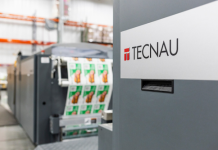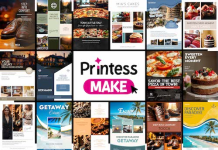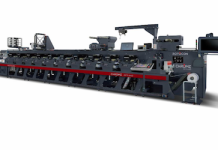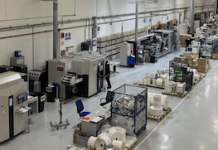James de Waal, head of Marketing Business Imaging Group, Canon South Africa, discusses the role of graphics in creating seamless brand experiences.
Over the last decade, retail brand owners have come to the growing realisation that traditional marketing is no longer enough to increase footfall to their stores and boost sales. Customers now expect immersive experiences with brands that engage them at different touchpoints along an extended buying journey in a way that reflects their individuality.
In turn, brand owners need to use multiple marketing channels and formats to connect with customers emotionally, cultivating an ongoing dialogue with their target consumers that delivers a more personalised and memorable customer experience, while driving commercial success for the brand.
Integrated multi-channel campaigns are becoming increasingly sophisticated, thanks to the proliferation of digital marketing tools and platforms and access to in-depth customer analytics. This digital insight has enabled retail brands to interact one-on-one with consumers while tracking their browsing and purchasing behaviours.
Against this backdrop, print plays a key role in nurturing the all-important emotional connection between brand and consumer at every touchpoint, while the evolution of digital on-demand print in tandem with digital marketing boosts the combined effectiveness of both channels. They are at their most impactful when they work together to create seamless brand journeys for customers, and when campaigns evolve dynamically to reflect response data and competitor activity.
Print’s impact on purchasing behaviour becomes particularly strong in the physical retail environment, where applications such as posters, banners, window graphics and Point of Sale (POS) displays play a measurable role at what marketers call the ‘first moment of truth’: the point at which the consumer encounters the product in a ‘real world’ setting.
While most brand owners will understand the role these retail graphics and POS materials play in their marketing mix, they may not be fully aware of the extensive choice of graphics and installation systems, or of the opportunities created by the advances in digital print technology to make their campaign materials more relevant, dynamic, impactful and commercially effective.
Print Service Providers (PSPs) who take time to understand the brand owner’s campaign objectives and the structure of the overall campaign, rather than simply fulfilling an order for a given quantity of graphics, have the potential to add significant value, elevating response and putting print at the heart of the brand experience.
For example, brand owners may appreciate proactive advice from their PSPs on production techniques to make graphics more visually arresting, or how to use stand-out materials and finishing techniques to add the ‘wow’ factor and stop consumers in their tracks.
When it comes to marketers’ understanding of the performance of graphics in real retail settings, PSPs can also add value and encourage repeat business by guiding brand owners to specify graphics that are technically fit for purpose. This may be in terms of image quality relative to viewing distance, durability and portability, and ease of installation and removal, particularly in light of the growing trend of the installation of short-term graphics by store personnel.
PSPs can also be proactive in highlighting the strengths of digital production capabilities and how they are attuned to brand owners’ commercial drivers. Brand marketers who have grown up in the ‘instant-hit’ digital marketing environment may perceive print as a ‘slow’ medium, associating printed graphics with old-world analogue production and distribution models. It’s important that PSPs dispel those perceptions, emphasising the many commercial advantages of digital print, such as the ability to meet just-in-time expectations, reduce overall volumes of promotional print by ordering on demand, limit inventory costs, and minimise waste.
Time-to-market is everything for contemporary marketing campaigns, a truth that plays to digital print’s strengths more than many marketing decision-makers realise. Brands can have promotional graphics ordered, produced digitally and distributed in very short timeframes, thanks to web-to-print systems linked to digital production technology, and distributed production/distribution models. For complex retail organisations, even across multiple territories, design can be centralised, costs agreed upfront, proofs shared instantly, and orders confirmed in minutes online.
Of course, digital production and just-in-time delivery offer additional benefits, such as the ability for marketing departments to easily customise content, from text and images, to language versioning, to variable response mechanisms. This on-demand capability enables brands to adapt campaign messages dynamically as they evaluate campaign performance, or update materials at intervals with tailored, more targeted content, to increase customer engagement and response.
The golden opportunity for producers of retail graphics is to show brand owners how print can increase the effectiveness of their multi-channel campaigns by being deployed at specific touchpoints in the customer journey and incorporating tailored response mechanisms to increase and monitor effectiveness.
‘Smart posters’ are a good example of how print can tie in seamlessly with a digitally-led campaign. With an embedded Near Field Communication (NFC) inlay that enables interaction with smart phone devices, smart posters create innovative avenues for brand communication and promotion, while also offering new ways to measure ROI on print advertisements.
Quick Response (QR) codes are an effective alternative for stimulating mobile-based interaction with printed posters and POS displays, while including variable geo-specific content and response mechanisms allows campaigns to target specific micro-audiences in select locations.
Augmented Reality (AR) technology can make print come to life with digital content by combining a handheld smart device and a specially designed graphic, transforming the image into interactive media on the smart device screen, enhancing the in-store experience by offering the customer engaging extra content.
POS displays don’t need to be passive; customers are more likely to engage with a retail display if it encourages interaction, for example via sampling booths or using promotional codes or NFC tags that redirect to online content. A printed POS unit can be designed to integrate with a digital POS display or complement product packaging, increasing the overall visual impact of the filled display and reinforcing brand identity. Special edition or promotional packaging designs can also be reflected in short-term POS to maximise consumer recognition.
Producers of retail graphics may also capitalise on the growing trend to combine printed graphics with other visual communication technologies to grab attention. For example, printed window graphics can be deployed together with projector technologies as part of a dynamic, more sophisticated visual solution. The use of high brightness, high-quality laser-based projectors maximises impact and significantly enhances the customer’s shopping experience. By combining the projector with a rear projection film, a retail shop window can be brought to life through eye-catching media content, such as images, videos and animation.
Finnish company Ostosikkuna delivered an innovative consumer experience, turning a real estate agent’s window into an interactive touchscreen by combining a special film with two Canon XEED WUX6000 projectors and a standard zoom lens. Onlookers were able to browse through images and watch clips of properties simply by swiping the window surface.
There is a significant part for printed graphics to play in measurable multi-channel marketing and enormous scope for forward-thinking brands to find smart ways to integrate graphics in their campaigns. For graphics producers, the opportunity for business development lies in being more than just an efficient PSP and fulfilling the more valuable role of trusted business partner. By applying their deep technical expertise, blended with knowledge of effective visual communications and overlaid with an understanding of how print fuels emotion to stimulate response, PSPs are in a unique position to help brands deliver stand-out retail graphics that are dynamic, integrated and impactful.
CANON SOUTH AFRICA (PTY) LTD (+27 12) 675 4900 www.canon.co.za





















